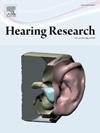Checkerboard cellular pattern in auditory epithelia: Implications for auditory function and sensory pathology
IF 2.5
2区 医学
Q1 AUDIOLOGY & SPEECH-LANGUAGE PATHOLOGY
引用次数: 0
Abstract
Sensory epithelia are composed of specialized cells arranged in specific patterns essential for function. The auditory epithelium of the organ of Corti features a highly conserved checkerboard pattern of mechanosensory hair and supporting cells, preventing direct hair cell contact and preserving epithelial integrity. In mice, disruption of this pattern results in deafness due to hair cell apoptosis caused by abnormal adherens and tight junction formation and structural fragility. This pattern is evolutionarily conserved across species, highlighting its functional significance. Direct hair cell contact, which normally does not occur, leads to abnormal adhesion molecule accumulation, altered ion permeability, and subsequent cell death. The checkerboard pattern likely evolved to optimize hair-supporting cell interactions while maintaining epithelial stability. This review explores the physiological significance of this cellular arrangement in auditory function and the consequences of its disruption, which leads to hearing loss. Understanding the mechanisms governing this pattern may provide insights into hearing disorders and potential therapeutic approaches.
听上皮的棋盘状细胞模式:听觉功能和感觉病理的意义
感觉上皮由特化的细胞组成,这些细胞以特定的模式排列,对功能至关重要。Corti器官的听觉上皮具有高度保守的机械感觉毛和支持细胞的棋盘图案,防止毛细胞直接接触并保持上皮的完整性。在小鼠中,这种模式的破坏导致耳聋,这是由于毛细胞凋亡引起的异常粘附和紧密连接形成和结构脆性。这种模式在物种间是进化保守的,突出了它的功能重要性。毛细胞直接接触,通常不发生,导致异常粘附分子积累,改变离子渗透性,随后细胞死亡。棋盘图案的进化可能是为了优化支持毛发的细胞相互作用,同时保持上皮的稳定性。这篇综述探讨了这种细胞排列在听觉功能中的生理意义以及它的破坏导致听力损失的后果。了解控制这种模式的机制可能为听力障碍和潜在的治疗方法提供见解。
本文章由计算机程序翻译,如有差异,请以英文原文为准。
求助全文
约1分钟内获得全文
求助全文
来源期刊

Hearing Research
医学-耳鼻喉科学
CiteScore
5.30
自引率
14.30%
发文量
163
审稿时长
75 days
期刊介绍:
The aim of the journal is to provide a forum for papers concerned with basic peripheral and central auditory mechanisms. Emphasis is on experimental and clinical studies, but theoretical and methodological papers will also be considered. The journal publishes original research papers, review and mini- review articles, rapid communications, method/protocol and perspective articles.
Papers submitted should deal with auditory anatomy, physiology, psychophysics, imaging, modeling and behavioural studies in animals and humans, as well as hearing aids and cochlear implants. Papers dealing with the vestibular system are also considered for publication. Papers on comparative aspects of hearing and on effects of drugs and environmental contaminants on hearing function will also be considered. Clinical papers will be accepted when they contribute to the understanding of normal and pathological hearing functions.
 求助内容:
求助内容: 应助结果提醒方式:
应助结果提醒方式:


